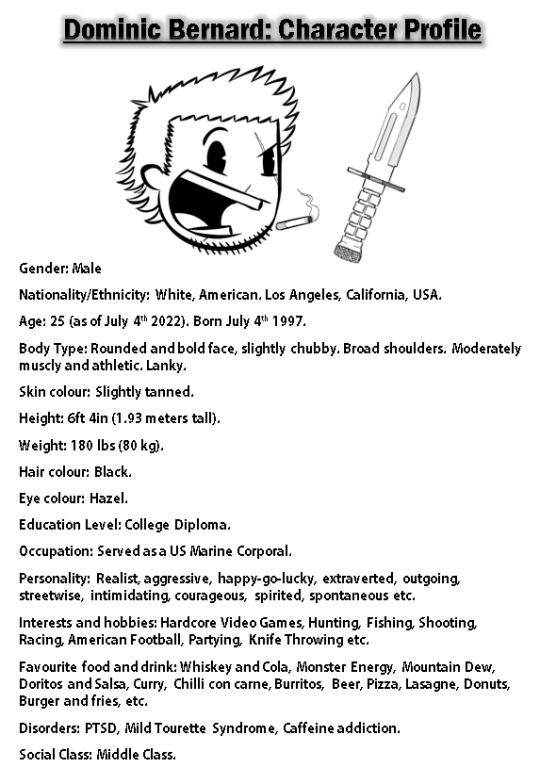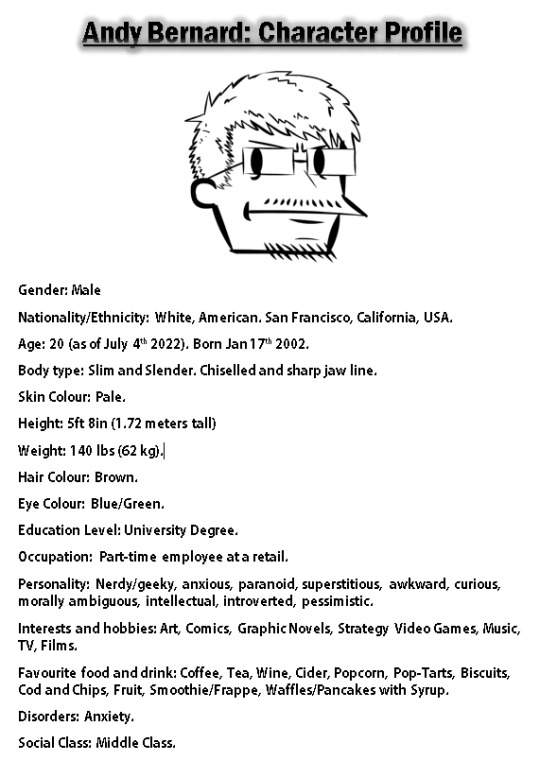Hello, my name is Jack Tiffin. This blog is dedicaed to the work I've been creating for the course, "Interactive Media and Games level 3"!
Don't wanna be here? Send us removal request.
Text
Production Diary #3
Just like the graphic novel in the last project, we had to make it so that it is interactive in any way possible. With the help of the program Adobe Flash, it was possible to do so. When all of the design/drawing aspects of the production was done and everything was on the Graphic Novel. I started doing the post-production, this of course being the interactivity. Which included drawing everything out digitally in Photoshop, importing the the cropped images of the individual frames into Flash on separate layers. I have decided to make a navigation button on my Graphic Novel, so that when the viewer clicks on it, the next frame or next scene will appear. How I have done this, is that I drew and arrow saying “next frame” in the direction the Graphic Novel, so that when the viewer clicks the button, the next frame/scene will appear. How I have managed to do this, is by converting the arrow to a symbol as a button, then I added a Code Snippet to it called “click to go to next frame and stop”, which is the exact command I want the button to perform. Then, I added “stop () ;” to every single layer/frame so when I go to play the graphic novel, everything will work properly. I did this exact method in the “No Evil” project, so I thought that I should add a bit more in this current project, such as including extra animations to separate assets in the frames. Like adding camera panning/scene transitions or character/object movement, when you click a button. Maybe even some sound effects as well when you click the button, to bring some immersion into the Graphic Novel. But in the end I didn’t actually manage to implement those features unfortunately, because of how advanced and complex it is to do those methods.
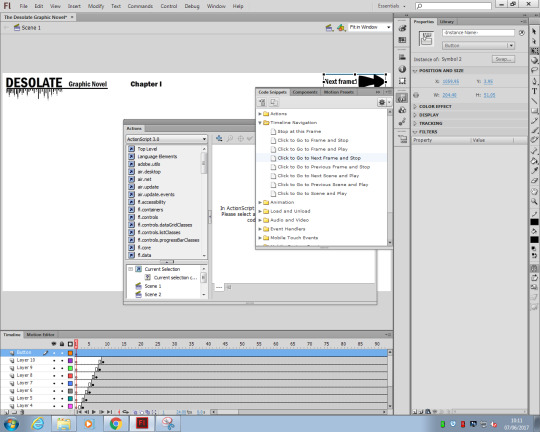
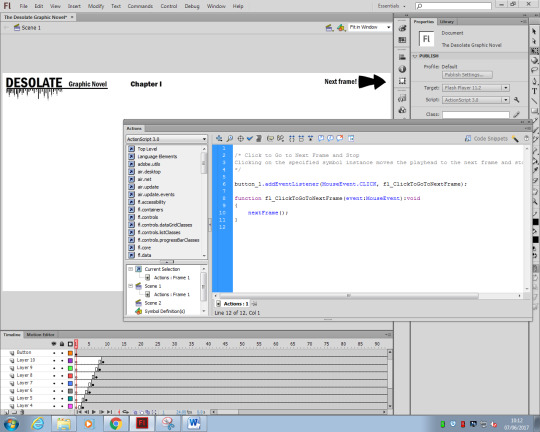
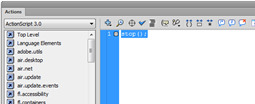
0 notes
Text
Evaluation. (As of 08/06/17).
At the very start of the project (Unit: 8 Survive and Thrive), I began working on pre-production for my graphic novel called “Desolate” before the Easter Holidays. The various documents I had to produce, that my overall final product shall reflect/follow on, are as follows. My One sheet, Design Document, Gantt Chart, Proposal, Storyboard, Pitch Presentation and Character Profiles etc. In the last project “See No Evil, Speak No Evil, Hear No Evil”, I made a graphic novel that I was satisfied/contented with called “Food Hell”, as I felt I did better with it than the Game and Animatio. What I liked most about doing a graphic novel though, was the interactive elements that you had to make such as the buttons and how it would navigate through the frames/scenes one-by-one. But this time I wanted to improve my skills and try out new techniques of making a graphic novel interactive, like adding animations and sound effects to it as well. Like when clicking a button, the direction/camera placement and angle will change or character movement, along with the sound effects to cue when something happens to bring some immersion into the graphic novel. Unfortunately though, I did not manage to make those happen in the end, as I thought that doing the blog work/missing pre-production (including research, production diaries and analysing products etc) was more crucial for meeting the assessment criteria. Also, it would’ve taken a while to create the animations and the coding behind it, as it is more complex than just having the frames appear when clicking a button. Coming towards the end of the project with the deadline just coming up (June 9th), looking at my graphic novel now there are definitely some differences and similarities from what I initially intended my graphic novel to be before, which is the concept idea. I can confirm that my graphic novel isn’t completed or polished 100% by no means, meaning that not everything that I planned to implement or incorporate into my graphic novel is there. This could be due to the time limit/restraints we were given, as we had about 2 months (from April to June). Also, we only have 3 days of College, one of them not being a full working day. Sometimes there were bank holidays, that got rid of time to work on our production. On some days, time to do work in lessons were taken away from any other occurrence that prevented us to work. A weakness that I have when it comes to this project, is that I’m too much of a perfectionist when it comes to me making art. I tend to spend too much time on details and I feel the need to draw something till I’m completely satisfied with the way it looks, for example proportions/scale of a human body or structure. Lack of equipment/tools needed in order to make the graphic novel, is another problem that I’ve faced when wanting to continue making my graphic novel at home. Programs such as Flash and Photoshop (which are the two programs that I have decided to do production on), are essential to the construction of my graphic novel and you have to pay monthly or pay an even larger amount to keep the Adobe programs forever. Not everyone, including me, can afford it. The same goes with the Microsoft Office programs (Word/PowerPoint for example) and audio editing software such as Audacity or FL Studio. Lastly, maybe your hardware of your computer is obsolete and weak so that stops you from being able to run the programs quickly and efficiently.
I have been recording down my progress of the production of my graphic novel through multiple “Production Diaries”, where I show natural progression of what stage I am at with making the graphic novel. Throughout the diaries I have portrayed how I might have changed/tweaked some things to what I said I was going to do in my Proposal. Though, I have kept a lot of things in my graphic novel the same as to the last project graphic novel, in terms of structure, art-style and colours etc but in this graphic novel I have refined those features. I am willing to push myself further and familiarise myself with new things in the overall course, instead of doing the things I’m already confident enough with, when I get the chances to. Unlike before in the last project, I didn’t do the process of drawing and sketching out the main outline/template of my graphic novel onto A3/4. Then scanning it into Photoshop to draw over the graphic novel on each frame digitally, till eventually importing each frame layer-by-layer into Flash, so I can construct the graphic novel so it works. Instead I have gone straight to drawing all out in Flash, so I can save more time where as last time I traced over the sketch template, making the graphic novel look more accurate to how it was drawn last time without change or mistakes. Which would’ve been a bit handier, but I’m happy enough to just add more detail as I go on drawing, without guidance of a template. Throughout the project, I have been researching/analysing multiple comparative (existing) products/medias that has helped me build my influence on the themes, scenarios, characters and design/art-style of my graphic novel. I didn’t just have to talk about existing graphic novels, just because I’m doing a graphic novel. I mostly looked at games, but I could’ve looked more into movies and TV shows as well. I have explained in more detail about these games in separate blogs. I have done Fallout 4: Far Harbor, Metro 2033/Last Light (book and game) and Far Cry 3. I have portrayed how I have effectively communicated to my target audience, through a recent blog post called “Primary Target Audience Research”. In it, I have explored how my graphic novel is suitable for my main target audience, by analysing the specific age group (16-25) on anything, such as what they like and dislike or what they are mainly engrossed into like genres of games, films, TV shows etc. I’ve also done a some blogs on how I will go about doing my research in “Research Proposal” and what I am going to include in my pre-production in my blog “Pre-Production”.
1 note
·
View note
Text
Primary Target Audience Research.
Reflecting back at my Target Audience Bio I made, I have decided to aim my graphic novel (Desolate) towards the suitable ages of 16-25, as I feel that having a smaller age gap makes easier research specifically about the age group. The many reasons why I believe that my target audience is at the appropriate ages for my project, is as follows. Both characters in my graphic novel, Andy (aged 20) and Dominic (aged 25), are aged like that so the viewers can relate and understand them a bit more, making the characters more diverse or compelling. They may like the personalities, interests and hobbies that my characters are in to, such as Video Games, drinking/partying, sports etc. So stuff that the average adolescent or young adult like to do, though I’ll try not to be too stereotypical because the age range covers a broader spectrum of life styles. Say for instance some people are very nerdy/geeky (niche), or they are either introverted/extroverted and etc, it can be extremely specific on what the individual of those ages is like. I’ll try make a unique and original art-style (or even distracting), to intrigue the viewer so that their attention span towards the graphic novel is high. I would like to add some forms of violence (which doesn’t exactly has to be action packed), suspense, tension or conflict among some scenes to carry on engaging/captivating the audience and making it so that the graphic novel isn’t monotonous/dull. The theme for my graphic novel is very dark, as it involves some mature/suggestive themes such as threat, torture, psychological, strong language and of course violence, which are comprehensible/coherent for ages 16+. The setting and situation of my graphic novel, is about a supervolcanic island (Nukunonu) which is the home to 10 cities inhabited by civilians that are occupied by a secret United States governmental corporation, that are conducting bizarre and classified experiments. The supervolcano erupts, turning the entire island into a post-apocalyptic wasteland. Before, I’ve researched a couple of comparative products (existing) that have similar and relevant themes surrounding the themes for my graphic novel as well. Those being video games that are targeted towards the same age range (PEGI 18+) such as, Metro 2033/Last Light, Far Cry 3, Tomb Raider (2013), Fallout 4: Far Harbour, Just Cause 3, Stranded Deep and Crysis etc. I have looked at one graphic novel that is suitable for my target audience and that is Sin City.
0 notes
Text
Fallout 4: Far Harbor Analysis.
Fallout 4: Far Harbor is an expansion pack for the 2015 Action RPG video game Fallout 4, developed by Bethesda Game Studios and published by Bethesda Softworks. I thought that I would take some inspiration from this game, even though it’s not a graphic novel like I’m doing. The game centres around a mysterious post-apocalyptic island, that is completely covered by a very thick, radioactive fog from the nuclear bombs that were launched in the Great Resource War of 2077. With my graphic novel (Desolate), in the year 2022 a Super volcano erupts on the island of Nukunonu, which emits a huge amount of ash into the atmosphere and on the surface blocking out the sun and then creating a Volcanic Winter. Taking inspiration from Far Harbor, the thick ash engulfs Nukunonu so the island is inhabitable and invisible, with the air pollution killing off all living organisms. Far Harbor is also inhabited by deadly and strange mutant animals and people, such as Feral ghouls and Deathclaws etc. The atmosphere of the game is very eerie and unsettling, making you feel quite discouraged or anxious when exploring the desolate wasteland. The sinister ambient music helps with setting the mood of the game as well. The colours in Far Harbor are very grizzly, desolate and grim with blends of a bleak green/grey/blue. My art style for my graphic novel only aims for black and white, with some shades of grey in between. There is a lot of devastated/annihilated vegetation on Far Harbor, whereas the same with my graphic novel which is also set on a post-apocalyptic island (Nukunonu Island), though due to a natural disaster involving a Super volcano, not a nuclear holocaust. Fallout 4: Far Harbor’s lore includes factions or cults, such as the Church of the Children of Atom, Acadia and the citizens of Far Harbor. My graphic novel will feature uncharted tribes/cults that worship the Super volcano, along with cities populated with civilians that are occupied by the US Government.
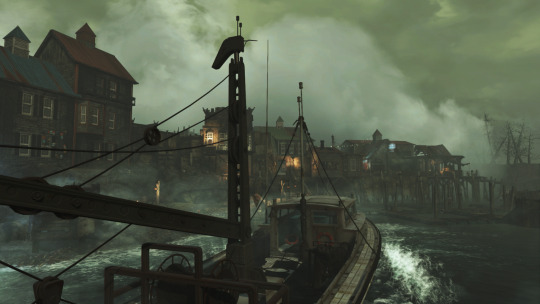
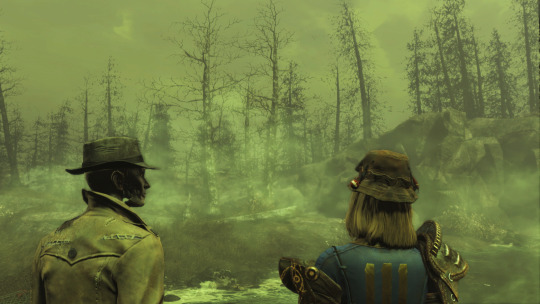
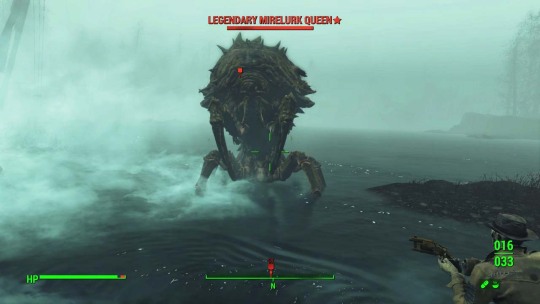
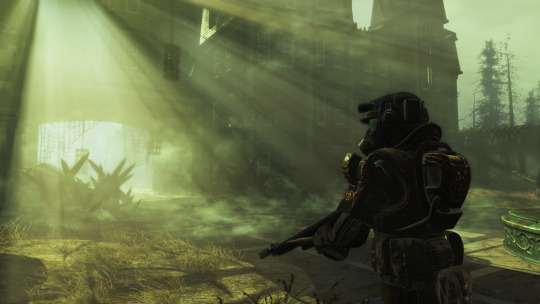
^ These are just some of the screenshots taken from Fallout 4: Far Harbor.
Disclaimer: I understand that I’m spelling “Harbour” in the American way, but I wanted the title of the game the way that it’s published as for reference.
- (2016, Bethesda Softworks and Bethesda Game Studios)
- 1st pic http://gameranx.com/features/id/54543/article/fallout-4-far-harbor-dlc-unique-perks-how-to-unlock/
- 2nd pic https://www.theverge.com/2016/5/24/11760860/fallout-4-far-harbor-expansion-review
- 4th pic http://fallout.wikia.com/wiki/Far_Harbor_(add-on)
0 notes
Text
Production Diary #2 (05/06/17)
During the course of the past week, I have accomplished some progress on the second page of my graphic novel. I have still yet to add the interactive segments to my frames though, such as the buttons for example. Two frames of my graphic novel that I created before production, were exported into PNG images so I could then import them into Flash. The only problem though, was that the image quality wasn’t very good at all and was very pixelated. So I had to open the original Flash documents of the art, then copy and paste them into my graphic novel, only then the frames looked higher quality. I have also added dialogue/context of what’s happening in the graphic novel, so for example the scene setting. Since this is my 2nd page of my graphic novel, I didn’t want to do it on a different document, so what I did was I made another Scene to make it so that the next page appears when the viewer clicks on the “next frame” button, after when all the frames on the previous page has appeared. The frames on the second page follow through the same structure as the last page, which is going right, top to bottom horizontally. Frames that are stacked vertically, go from top to bottom. The same goes for with the layers, they are all separate, with some assets within a frame that may be separate as well, because they are going to be animated or interactive in a way. I have been using another version of Flash than in the other rooms, which is Adobe Flash Pro CC 2015. Which isn’t too different from the others, with having newer features and a different structure as to where all the tools are etc. The colour of the program is very dark, which allows me to see what I am drawing more clearly and the stage stands out/looks more bold as well.
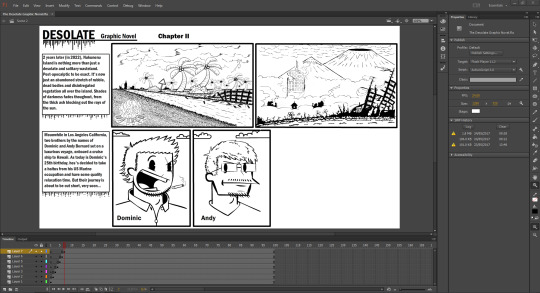
0 notes
Text
Production Diary #1
So far for my graphic novel, I have managed to complete a storyboard/basic outline of what the finished/final product will look like. Not only that, but how the interactivity will work (buttons/navigation) and what sound effects/music will be added it. Animation will incorporate movement of objects, characters, setting/scene and camera angles etc. I have also completed designing the first page of my graphic novel by drawing every frame out (including dialogue, but I haven't refined it by implementing the coding and the animation. First of all, I started off with drawing out each separate box of the frames, with the line tool. They were all in separate layers, because if something were to go wrong I can easily identify what layer the mistake was on, so then I can quickly/efficiently resolve the problem. The content that goes in the frame box may or may not be on the same layer, as some drawings may be subject for being animated or is interactive in any way. I didn't want too many layers in my graphic novel, because it would be too confusing and complicated to find which frame is which. So I named each layer to their specific frames. I'd like my graphic novel, so when you click the "Next Frame" button, the next frame will appear. To do that, each key frame on the separate layers will step up throughout the timeline. This will make it so that all the frames will not pop up all at once and will only appear when the button is pressed.
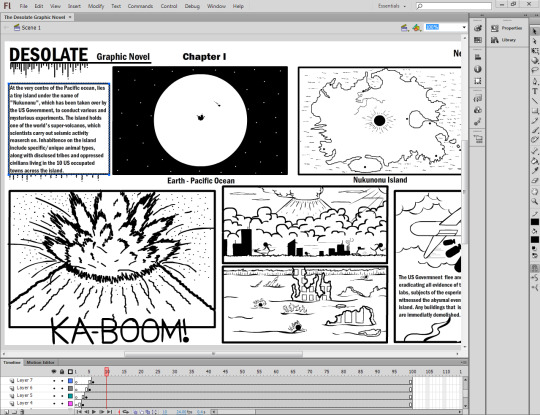
0 notes
Photo
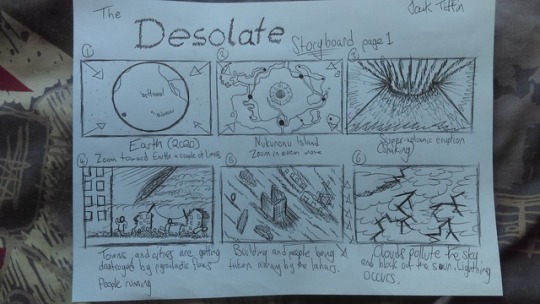
Rough storyboard for my graphic novel. As you may see, I have included some stage directions/camera pans of some specific frames. I will do this by using the animation technique called “Motion Tweening”. I have also implemented/explained what sounds I’m going to incorporate into my graphic novel as well.
0 notes
Photo
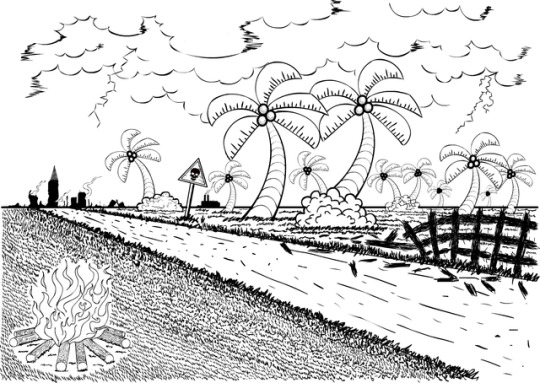
Just a frame that I drew entirely in Flash, that I shall put into my graphic novel. I spent waaaaaaaaaaaay too much time making this, especially when it came to the grass...
0 notes
Text
Making a Script.
Today we learned how to create a professional screenplay/script by using an existing segment from a novel that wasn’t formatted properly, then correcting it so that the structure is similar to an actual script. We used the website Celtx (2017), which makes writing a script very easily and quickly/efficiently. “Syd Field’s Screenplay: The Foundations Of Screenwriting” (2005) shows the 11 formatting rules of making a script in a specific order, but I’m only going to describe 5 of them.
Line 1: The Slug Line or Scene Heading
The Scene Heading is a very short description of that what specific setting/location the scene is situated at, like for example “EXT. DESOLATE WASTELAND/LANDSCAPE - DUSK”. This will also place where the characters are as well.
Line 2: Text or Action
This will display and portray an action or movement of a character/event. It is mainly used for the description of people, places or action. It doesn’t have to be a paragraph long, maybe just a few sentences/ few lines. The more white space on the page, the better.
Line 3: Shot or Camera movement
This specifies a change in camera focus or frame. It is a suggestion from the writer, not an instruction.
Line 4: Minor Location Change (same scene)
The setting/enviroment is still the same, but the position of the location has changed. Lets say change from outside to inside a Jeep and the characters. Major focus on a specific character, they are the subject of the shot.
Line 5: Speaking Characters and New Characters
The name of the characters or characters that are introduced are always in capital letters. The name of the characters speaking is always centered in the middle of the script.
Since I’m doing a graphic novel, this may come in handy a lot for the purpose of dialogue, what the characters are doing, sound effects and transitions of the frames. I may incorporate some forms of animations in my graphic novel as well, so the script will help guide me on where and how to animate my frames. Scripts are mainly used for Movies, TV shows etc, where as graphic novels rely on storyboards.
Celtx is very accessible, fluid and hassle free, the moment you open a script file it's ready to go. No adjusting margins or setting up tab points; no need to worry about capitalization. Just type, enter, move on. The Celtx. (2017) Using the TV and Script Editor tutorial video shows you everything you can do using Celtx, such as the formatting rules I explained above. Auto-fill techniques such as pressing Tab at the beginning of an Action line, you'll switch to character. Hit enter after your scene heading and you're typing action. Hit enter again for another paragraph. After entering the character's name, ENTER will bring you to dialogue.
0 notes
Text
Scheduling Blog Post - 03/05/17
At the moment, we are coming to the end of making our “Pre-Production” for either our graphic novel, game and animation. The deadline for the Pre-Production is on Friday 12th and I’m sort of falling behind with a few things, such as my character profiles, scripts, storyboard and Design Document (basically a GDD, but not for a game). I have managed to make my proposal, one sheet, concept art, Gantt Chart and research/research proposal etc. The next thing I’ll need to start working on, is the production for my graphic novel.
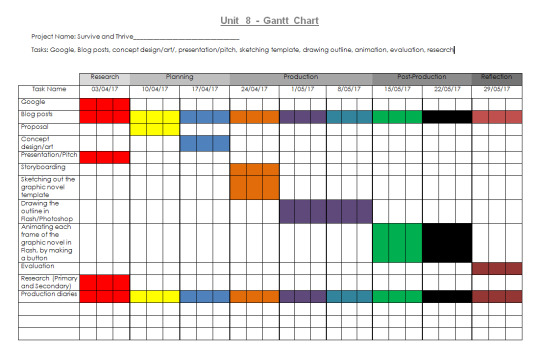
0 notes
Text
Target Audience Bio
Age: 16+, 16-25
Gender: Male
Location: Anywhere (but mostly the UK or USA)
Martital/family status: Not Married
Income level: Minimum Wage or over
Education Level: College, University
Occupation: Unemployed/Part-time/Full-time
Attitude: Immersed into things easily. Likes narrative. Resilient. Curious.
Values: Morally ambiguous
Interest/Hobbies: Art. Comics. Graphic Novels. Video Games. Music. TV. Films.
Behaviours: Slightly anxious and paranoid. Solitary.
Which games has the audience been playing?: Metro: 2033/Last Light, Far Cry 3, Fallout 4: Far Harbour, Tomb Raider (2013), Crysis, Just Cause 3, Stranded Deep
How can I best reach the target audience: I will make my characters so that my target audience may relate to them. Have unique and original art style, to attract the viewer’s attention/interest them. Add some forms violence, tension, suspense or conflict in the graphic novel, to engage the audience and to not make the graphic novel boring.
1 note
·
View note
Photo
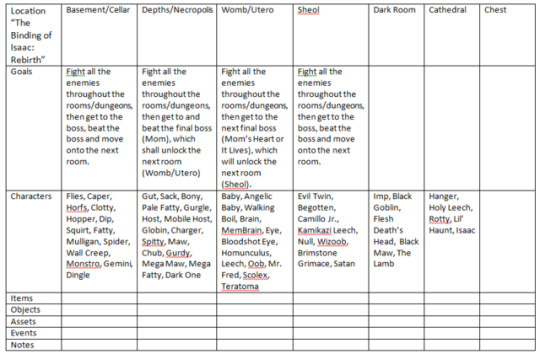
A Beat Chart for the game "The Binding of Isaac: Rebirth", which is unfinished. A Beat Chart consists of the locations of the game and what assets/objectives etc. the specific level has.
1 note
·
View note
Text
Research Proposal
Before I make my graphic novel, I shall need to conduct and discover/explore the various methods of Primary/Secondary or even qualitative and quantitative research, that I will use for my specific target audience.
Primary:
Since Primary research is all about finding your own results, I reckon these methods should be the most handiest and applicable for my repercussion. Starting off with an Online survey or questionnaire, is an easy way for the public to leave their opinions on what they like, or dislike about your concept idea. This way, it is easier to find what age range/gender etc. the people are that would like the look of my graphic novel. Focus groups are another good example of primary research. They are a group of people assembled to participate in a discussion about a product before it is launched, or to provide feedback on a game, movie, television series, etc. Also face-to-face surveys may be a good idea as well, as you can interact with your target audience in a more genuine way. Looking at reviews online, of anything I took inspiration on for my graphic novel or anything identical theme/art style wise, is a great way of looking at any advantages/disadvantages of the graphic novel and whether I should avoid/focus them in my graphic novel. Having interviews with developers of games or illustrators and authors of a book is a great idea as well. I can elaborate on quantitative and qualitative surveys or questionnaires in he public or specific communities. I can use tally charts to collect and investigate/explore he data from people, then convert the results into a line chart or bar chart. So then, I will be able to notice the difference between each answer.
Secondary:
Secondary research is all about finding already existing research/information and is basically quick factual and analytical research. I can use Online data that has already been explored or collected by a originator or a distributor i.e. Lets say a third-party organisation website (game developer or publisher)/e-magazine articles have sources related to things that I need to know about. I can look at existing graphic novel products and have a look at their graphics, colours, animation style if any. Compare different graphic novels to find similarities and differences between each-other, or compare graphic novels to my initial idea. I will look for apps in the App Store and Google Play Store to find ideas on the art design, clichés, stereotypes on our target audience or other assets that will be suitable for my graphic novel. Recently I went to EGX Rezzed which is a Eurogamer event that happened in London, where lots of games were being showcased and developers of those games were there to discuss and give advice about what they do. Analysing characters from existing games, books, movies and graphic novels could be secondary research.
Here is some research that I have conducted already...
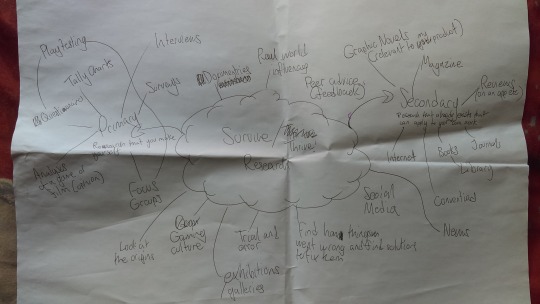
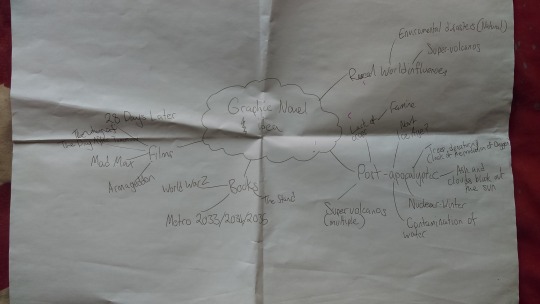
0 notes
Text
Pre-Production
Blog posts are crucial for recording/documenting my progress, research and learnings throughout the entire project (Unit 8: Survive and Thrive), not just before the actual production. Blog posts shall include valuable research on all the aspects of Graphic Novels, audio/music, primary/secondary research, using Flash (which is what I’ll use to draw out then make my graphic novel interactive) and interactivity ect.
My Proposal will portray on what I would like my Graphic Novel to be about and to be like. The proposal will consist of a personal review about myself, a project concept idea and lastly how I will do my evaluation. My evaluation will be backed up by my proposal when I’m comparing the differences/similarities as to what I ended up making, to what I originally wanted to make.
Concept Art will grant me the ideas, for what art style my graphic novel is going to have. I’m going for a cartoon like but semi-realistic/detailed art style, as I am more comfortable with it fitting to the theme of the Graphic Novel.
Story-boarding may come under pre-production as well, as it’ll give me an idea of what structure I plan the frames to be in, or what order. It could act as a template for where to draw, such as the character movement/position or where the onomatopoeia will appear. I’d love to make some small animations of whatever is happening on the frame, so the graphic novel will be more interactive. In the storyboard, I can add arrows for the directions and maybe describe sound ques that mix in with the actions.
0 notes
Photo
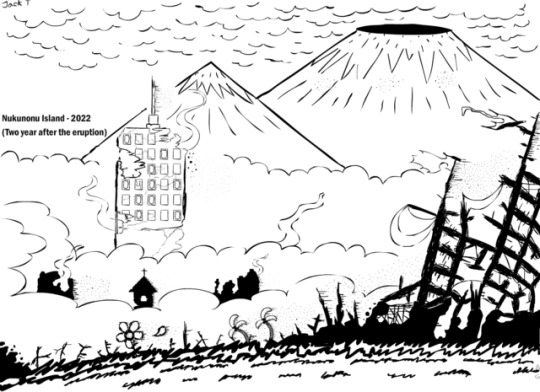
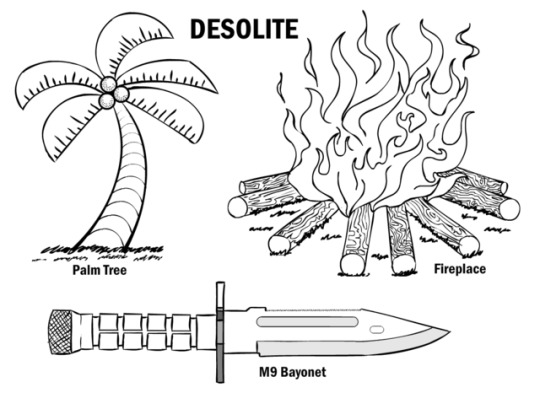
Some concept art I made in Flash for my graphic novel “Desolate”. As you can see I’ve spelt “Desolate” wrong on the second picture. Also, I mistaked a campfire for a for a fireplace as well. This is going to be the art style I’ll be focusing on, for making my graphic novel and I may or may not be using these specific assets in the final product. I mean, they kinda took a while to draw...
1 note
·
View note
Text
Gantt Chart
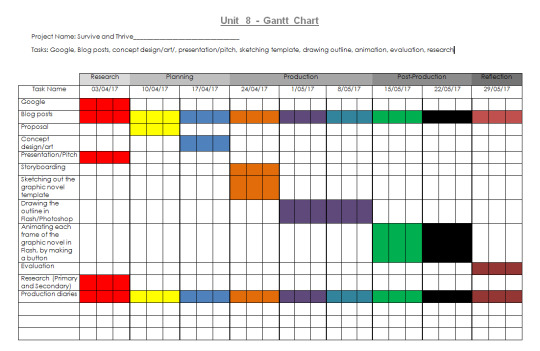
Today we discovered and had to make what is called a Gantt Chart. A Gantt Chart is a schedule which portrays the process of the overall project we are doing at the moment Unit 8: Survive and Thrive, so it’s kind of like a timeline. Each part is spread across a number of weeks, starting with Research, Planning, Production, Post-Production then lastly Reflection. The colours represent each week which they are all in their own desperate column, from April to June. Each row represents a task that we do to record the progress and how we will make either our Graphic Novel, Animation and Game.
0 notes
